-- Published: Tuesday, 21 March 2017 | Print | Disqus
By John Mauldin
Labor Market Limits
Men Without Work
How It Starts
The Big Question: Why?
Elusive Solutions
Dallas, Washington DC, Atlanta, Augusta, and Tampa
“America was not built on fear. America was built on courage, on imagination and an unbeatable determination to do the job at hand.”
– Harry S. Truman
“Unemployment is a weapon of mass destruction.”
– Dennis Kucinich
“Ever since 2000, basic indicators have offered oddly inconsistent readings on America’s economic performance and prospects. It is curious and highly uncharacteristic to find such measures so very far out of alignment with one another. We are witnessing an ominous and growing divergence between three trends that should ordinarily move in tandem: wealth, output, and employment. Depending upon which of these three indicators you choose, America looks to be heading up, down, or more or less nowhere.”
–Nicholas Eberstadt, “Our Miserable 21st Century”
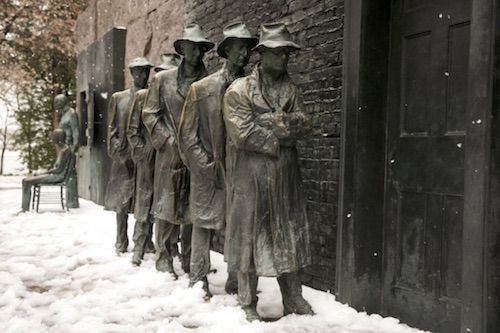
“Depression Breadline,” 1991, by George Segal
Angst is “a feeling of anxiety, apprehension, or insecurity.” Many of us feel it acutely right now – and that’s new. Angst isn’t a temporary, individual thing anymore. Now we all feel it together – or at least most of us do – and it’s not at all temporary. Millions can remember feeling no other way.
There’s a general sense in much of the developed world that we’re headed for more difficult times. Deficits increase, unemployment rises, and the benefits of the future – or at least the future that is already here (to paraphrase William Gibson) – have been unevenly distributed throughout society. It is not just in voting patterns that you can recognize the sense of malaise. You can see it in the economic numbers and in a lot of the psychological/sociological research.
Angst manifests differently in different countries. Consider Japan:
Recent research by the Japanese government showed that about 30% of single women and 15% of single men aged between 20 and 29 admitted to having fallen in love with a meme or character in a game – higher than the 24% of those women and 11% of men who admitted to falling in love with a pop star or actor.
The development of the multimillion-pound virtual romance industry in Japan reflects the existence of a growing number of people who don’t have a real-life partner, said Yamada. There is even a slang term, “moe”, for those who fall in love with fictional computer characters, while dating sims allow users to adjust the mood and character of online partners and are aimed at women as much as men. A whole subculture, including hotel rooms where a guest can take their console partner for a romantic break, has been springing up in Japan over the past six or seven years. (The Guardian)
Is it any wonder that there is a dearth of babies in Japan? It’s hard to get pregnant when a computer avatar is your companion. Young British women are literally 20 times more likely to have a pregnancy out of wedlock than young Japanese women. The cultural oddity of moe partially explains that fact.
While researching this topic I came across literally scores of similarly disconcerting statistics. For instance, the difference between the income and employment status of young males who grew up in two-parent versus one-parent homes is staggering, especially when you realize how fast the number of single-parent homes – generally, though not always, led by the mother – is rising. Less than half of US children live in a traditional family setting, according to Pew Research.
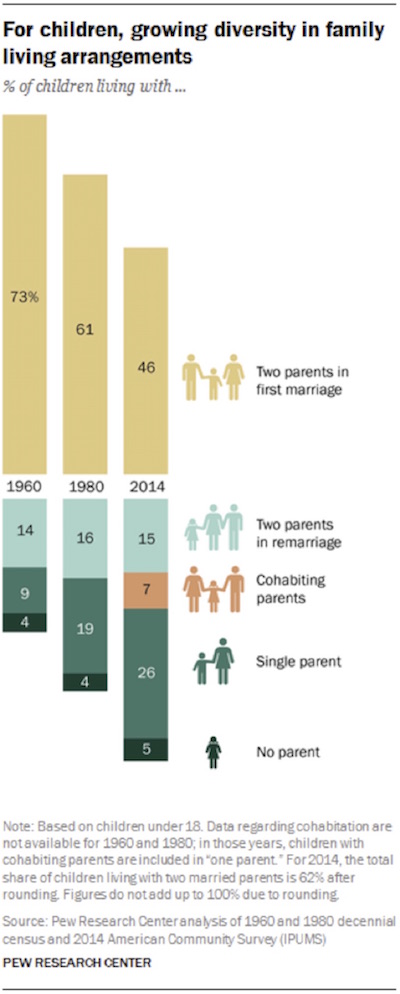
This week we begin a series of letters exploring the new economic and sociological anxiety. I want to look at what causes it and think about what we can do to ease it. I don’t know how many letters this dive will take. I may break away for other topics and then come back to the topic of angst. The one thing I know, based on my own experiences with family, friends, and business associates and the feedback I get from readers, is that we have a big problem.
In his first inaugural address, Franklin D. Roosevelt famously said, “The only thing we have to fear is fear itself.” In 1933 that wasn’t even close to true. They had plenty to fear: The US was already in the throes of a depression that would only get worse, and war clouds were forming across the Atlantic and Pacific.
Roosevelt didn’t have all the right answers, but he did one thing very well: He gave people hope. My generation heard from our parents, even decades later, how FDR helped pulled them through those hard times.
Of course, he had an important advantage today’s leaders lack: Television, talk radio, and the internet weren’t constantly reminding everyone how terrible things were. We didn’t know or care about the intimate details of our leader’s lives. Today, I am not sure even FDR himself could do what he did back then. Conditions are different now.
It is become increasingly clear to everyone that we are breaking ourselves up into tribes based on how we consume news. We consume our news from people who are generally ensconced in the same ideological bubble we are, which only reinforces our concerns and anxieties. If you think Donald Trump and Paul Ryan are taking us in the wrong direction, there are plenty of people who will agree with you and tell you so. If you think the people opposing them don’t understand and are distorting the truth, there are plenty of sources that will confirm your thinking. And both sides talk/shout over the other.
We have always had polarization among our news sources (even back in colonial times), but it has never been so ubiquitous before, or so extreme; and the news has never been so readily accessible, so that numerous “tribes” can live in the same physical neighborhood yet hear different versions and interpretations of the problems and directions in our country and the world. We no longer all listen to Walter Cronkite on the radio or TV or read the local newspaper for our news. There is no unifying national experience, just a disjointed series of intra- and intertribal interactions. (This is not just a US problem, but I’m going to be citing mostly US data.)

Labor Market Limits
It’s no wonder that so much of our angst is job-related. Some people don’t have jobs at all while many others don’t like the jobs they have. The millions of unemployed, underemployed, or unhappily employed touch all of us in some way.
If our nation’s work rate today were back up to its start-of-the-century high, well over 10 million more Americans would currently have paying jobs. And that employment shortfall makes a real difference to the growth of the economy. There are only two ways to grow the economy: You either have to grow the number of people working, or you have to increase their productivity. If you remove 10 million American workers from the labor force, not only are they not producing anything, the vast majority of them are obviously consuming the fruits of the labor of those who are employed.
As we will see, the number of people dropping out of the labor force is increasing, and if that trend is not turned around, the hope that we will get back to 3% GDP growth is simply wishful thinking. Couple that trend with reduced productivity and we will be lucky to see even 2% growth for the rest of the decade. If we have a recession, we will end up with a lower GDP than we have today. Think about that, and then plug it into federal budget projections.
Meanwhile, employers feel a different kind of angst. Many either can’t find qualified workers or their workers require constant attention and extensive training to be productive. Neither side of the labor-management divide is happy with the arrangements. Everybody is apprehensive about the future. The common complaint from businessmen is not that they need more capital and the ability to borrow money from banks, but that they need more good workers in order to attract more good customers.
This widespread dissatisfaction among employers, employees, and those who aren’t working is one big reason Donald Trump is now president. He paid attention to a large group of voters that others ignored, spoke to their anxieties, and won the White House. It was not simply working-class white males that he appealed to; that is far too simplistic an analysis. It was also their bosses, spouses, parents, and friends. A huge swath of the country was experiencing a yawning disconnect between the reality of their daily lives and the supposedly growing economy touted by politicians and media pundits. We focus on the anxiety of the white working-class male, but I challenge you to find me an identity group (however you want to define it) that isn’t anxious and concerned that things aren’t heading in the right direction.
American culture used to be known for its optimism, its can-do spirit. That quality hasn’t vanished, but it has surely lost some of its luster this century. You can see it fading in the statistics about the number of new business startups, which is now less than the number of businesses closing down. And that trend has been in place for almost a decade. The hope that the situation was temporary probably let people tolerate much worse conditions than they should have. But you can only look on the bright side so long before you get tired of waiting.
The change in direction that began at about the turn of the century is described clearly in Nicholas Eberstadt’s biting essay in Commentary magazine entitled “Our Miserable 21st Century.”
I will quote from that essay several times in this letter. If you take the time to read it, you should also read the pushback from my friend John Tamny, published in Forbes a few days ago, titled “Nicholas Eberstadt, Election 2016, and Self-Flagellation by the Elites.”
Men Without Work
One problem is data-related. The “labor force” from which we calculate unemployment statistics necessarily includes only those people who are either working or who wish to be working. It ignores the retired, those in school, the disabled, nonworking spouses, as well as those who are not interested in working.
That’s always been the case, of course, but the percentages vary. Even a 1% variance in the size of the labor force represents millions of people in a nation as large as the US. So the data got even murkier as the Baby Boomers approached retirement age. The oldest of that very large cohort turned 65 in 2010. Some probably retired early for various reasons. Others worked or will work well beyond the theoretical retirement age of 65, either voluntarily or not.
Regardless, it is definitely the case that a smaller percentage of the adult population is working now than in the past. The percentage declined in the early-2000s recession and never fully recovered before plunging in 2008–2010. We see only a very slight upturn after the recession ended.

The problem is particularly acute for men, though it affects women as well. Recently I read a marvelous book called Men Without Work: America’s Invisible Crisis by Nicholas Eberstadt, who wrote the essay in Commentary. The book is fairly short, and I highly recommend it. Eberstadt, who is a researcher at the American Enterprise institute, is very concerned with the large number of men in their prime who simply aren’t working. This isn’t a new development, nor is it restricted to men, but it is becoming more obvious. (At some point I will do a full review of the book.)
When Federal Reserve officials gathered last week to raise interest rates, they reviewed the data that says the economy is near “full employment.” That notion is laughable to millions of regular Americans. We all know, or at least observe, plenty of working-age males who could be working but are not. They don’t appear in the stats as unemployed unless they are “actively looking” for work. Or they may count as “employed” because they spent an hour or two doing odd jobs that month. But for all practical purposes they’re unemployed, and someone else is supporting them.
Eberstadt digs into the data and estimates that for every unemployed American male between ages 25–55, there are three more who are neither working nor looking for work. The number of those males presently in the labor force is down almost 4 percent since 2000. That’s about 5 million men who, for whatever reason, have dropped out of the labor force.
Here’s another and possibly even more startling number. Between 2000 and 2015, the total paid hours of work by all American workers rose 4 percent. The prior 15-year period saw a 35-percent increase in work hours. That’s bad enough, but it gets worse. In that same 2000–2015 period, the adult civilian population grew almost 18 percent.
With the population growing far faster than the total number of work hours, it shouldn’t be surprising that so many people aren’t working. And maybe they should be –you could surely argue that the work hours will appear if these people get busy and demonstrate their worth. In some cases that’s likely true, but the full picture is more nuanced. The downturn in labor force participation is a trend that has been going on among working-age men for over 60 years, and recently (and somewhat alarmingly) we have seen the same negative trend in working-age women. Let’s look at a few charts from the FRED database of the St. Louis Federal Reserve Bank.
This first chart shows the overall civilian labor force participation rate, which grew from the mid-’60s right up until the beginning of the century.
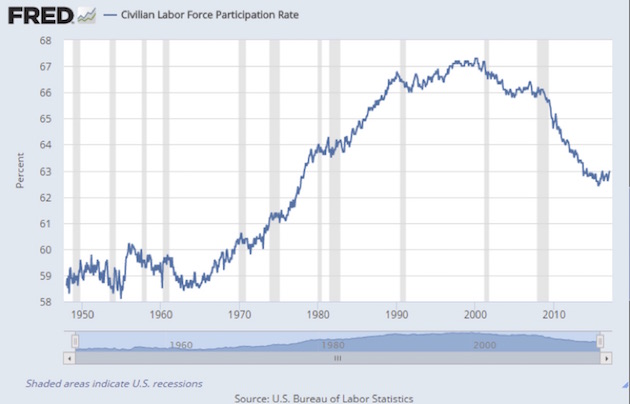
But that chart is misleading. It looks like things were just fine up until 2000, but that’s not the case. The next two charts show what really happened. The first chart is the male labor force participation rate. There is a bit of a statistical illusion in the way the data is framed, but let there be no mistake: The drop-off has been significant.
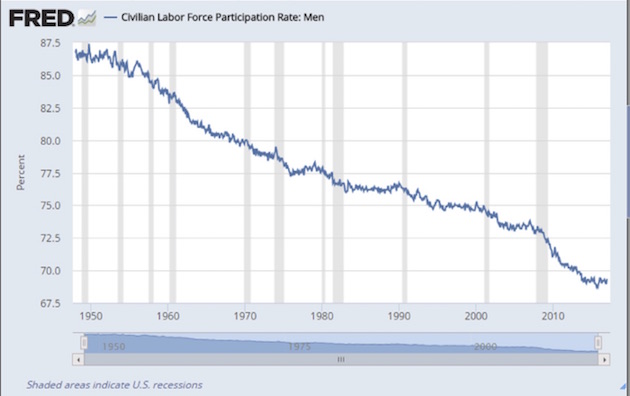
The next chart shows the labor force participation rate for both men and women. Note that the participation rate for women doubled in the 50 years up till 2000, while for men it went from almost 90% (87.4% to be precise) to just below 70% today. And that falloff has been steady throughout the entire period. This is not a recent phenomenon, although the downturn has worsened significantly since 2000. Notice that the participation rate since 2000 among women has been dropping at roughly the same rate as for men, at least in the last 6–7 years.
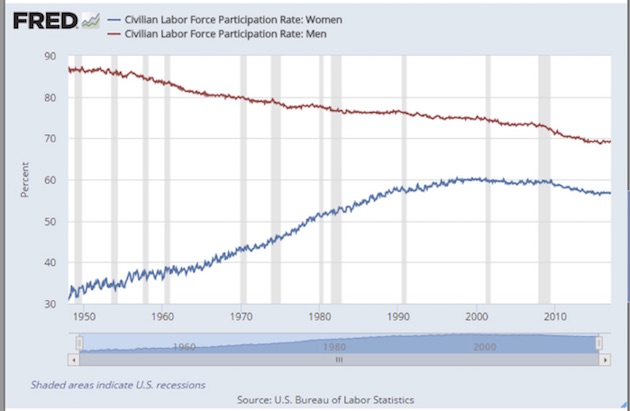
How Does It Start?
The progression from childhood to working adulthood used to be fairly standard. In an idealized form, which now seems almost mythological, it went something like this.
You grow up seeing at least one parent go off to work every day. You know from an early age that this is normal and necessary to support the family. When you reach your preteens, you get a starter job of some kind – paper route, mowing lawns, babysitting, etc. Maybe you get a regular job after school or in the summer. You finish high school and gain some independence from your parents by going to college or into the military, or by getting a full-time job, which may involve learning a trade. After a few years of saving your money, you’re ready for marriage and the purchase of a starter home. Then you live happily ever after. The End.
That sequence, to the extent it ever existed, is pretty rare now. The majority of children grow up in broken homes, see parents hop from job to job with little satisfaction, and in some areas grow up surrounded by crime and welfare dependence. Overcoming that kind of start to get on a positive path is hard. People still understand that education is critical, but it’s also more expensive than ever. Young adults take on student debt only to find the wonderful career they imagined isn’t so easy to come by.
Then there’s a second category. These are people who may grow up in stable surroundings, make all the right moves, get a good education, and start a rewarding career, only to run into a buzzsaw recession like we had in 2007–2010. They get laid off, burn through their savings, spend months or years looking for work, and eventually give up in despair. Then families break up, people move back in with parents, addictions form, and everything gets worse from there. And if such people do finally get another job, it comes with lower pay and fewer benefits.
On this topic, here are some quotes from “Our Miserable 21st Century.”
A short but electrifying 2015 paper by Anne Case and Nobel economics laureate Angus Deaton talked about a mortality trend that had gone almost unnoticed until then: rising death rates for middle-aged US whites. By Case and Deaton’s reckoning, death rates rose somewhat slightly over the 1999–2013 period for all non-Hispanic white men and women 45–54 years of age – but they rose sharply for those with high-school degrees or less, and for this less-educated grouping most of the rise in death rates was accounted for by suicides, chronic liver cirrhosis, and poisonings (including drug overdoses)….
All this sounds a little too close for comfort to the story of modern Russia, with its devastating vodka- and drug-binging health setbacks. Yes: It can happen here, and it has. Welcome to our new America….
By 2013, according to a 2015 report by the Drug Enforcement Administration, more Americans died from drug overdoses (largely but not wholly opioid abuse) than from either traffic fatalities or guns….
In Dreamland, his harrowing and magisterial account of modern America’s opioid explosion, the journalist Sam Quinones notes in passing that “in one three-month period” just a few years ago, according to the Ohio Department of Health, “fully 11 percent of all Ohioans were prescribed opiates….”
[N]early half of all prime working-age male labor-force dropouts – an army now totaling roughly 7 million men – currently take pain medication on a daily basis.
The Big Question: Why?
Again, both men and women are dropping out of the labor force at higher rates, but Eberstadt shows it is more common for men to do so. The trend is getting worse, too.
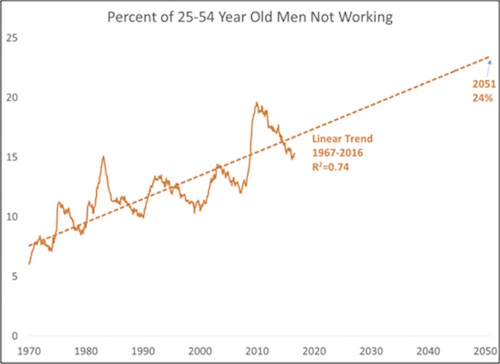
Larry Summers shared the above trend chart in his Men Without Work book review. You can see that the trend goes back way before NAFTA and factory automation were big factors. The percentage spikes higher in each recession then falls back, but in a series of “higher lows.” I generally hesitate to extrapolate this far into the future, but after six economic cycles with the same effect, I think it’s fair to call this a persistent pattern.
If the trend since 1970 does continue, nearly a quarter of all men aged 25–54 will be voluntarily jobless by mid-century. We should all hope the pattern does not persist, because I can’t imagine this scenario being good for anyone. Large numbers of unoccupied young males are rarely beneficial to social order.
But that outcome is totally possible. Let’s go back to what I was writing a few weeks ago. When six million truckers and taxi drivers are put out of work starting in 2025 (but will surely be out of the driver’s seat by 2040), along with most auto-industry repair and maintenance workers who now repair gasoline and diesel engines, and the auto insurance business too has been decimated, it is not hard to imagine a world in which 20%+ of the population is not part of the labor force. (And that’s just one industry.)
Set aside the future, though. We have millions of unoccupied working-age males right now. What are they doing all day? Survey data suggests they spend much of their time staring at screens, either TV or video games. They watch a lot of pornography. On average, they are in front of a screen for 2000 hours a year, about what most people spend working a full-time job. Many live with relatives or couch-surf between friends’ homes. They say they’ll look for a job when conditions improve, but that’s always tomorrow. They just drift.
I can’t find hard data, but I suspect this group works more than the surveys indicate. Much of the work happens off the books as they try to preserve government benefits or avoid child support payments. Nevertheless, they surely don’t have stable careers. Why not? What are the barriers? Here are a few, in no particular order.
Education: Many of the aimless males barely made it through high school and aren’t ready for college. Maybe they could get ready, but that would take money and dedication few of them have, especially after they are 30 years old. This limits their options to manual labor, low-end service work, or even less positive options.
Now, it’s easy for someone like me to say these men should swallow their pride and buckle down at whatever kind of work they can get. Yes, they should. But it’s one thing to work in the salt mines when you know you’re on your way to something better, and quite another when you know it’s the end of your road and you’ll never do better. That’s got to be discouraging. Given a choice between jobs like that and playing video games, it’s no wonder so many choose the virtual life.
Safety Nets: Our well-intentioned social programs can create a disincentive for people to work. That’s not always the case; sometimes people fall on hard times and need a temporary hand up, and society benefits by making them productive again. We need to do a better job of creating the right incentives and avoiding the wrong ones.
This also goes for disability benefits. You’ve seen the statistics on how many people suddenly acquired debilitating medical conditions during the Great Recession. To my non-physician mind, it seems like distinguishing between genuine disabilities and fraudulent ones would be simple. Apparently it’s not. Here again, we need to consider incentives and deliver the right ones. Eberstadt notes (again quoting from “Our Miserable 21st Century”):
By the way: Of the entire un-working prime-age male Anglo population in 2013, nearly three-fifths (57 percent) were reportedly collecting disability benefits from one or more government disability program in 2013. Disability checks and means-tested benefits cannot support a lavish lifestyle. But they can offer a permanent alternative to paid employment, and for growing numbers of American men, they do.
The rise of these programs has coincided with the death of work for larger and larger numbers of American men not yet of retirement age. We cannot say that these programs caused the death of work for millions upon millions of younger men: What is incontrovertible, however, is that they have financed it – just as Medicaid inadvertently helped finance America’s immense and increasing appetite for opioids in our new century.
Addictions: A startlingly high number of men without work take prescription pain medicines. Others use alcohol or other drugs. I’m sure many really are in pain, especially older men who worked on assembly lines or did other hard labor. Physical pain plus the discouragement of being unemployed plus happiness-inducing substances is a toxic and sometimes deadly combination. Quoting again from “Our Miserable 21st Century”:
You may now wish to ask: What share of prime-working-age men these days are enrolled in Medicaid? According to the Census Bureau’s SIPP survey (Survey of Income and Program Participation), as of 2013, over one-fifth (21 percent) of all civilian men between 25 and 55 years of age were Medicaid beneficiaries. For prime-age people not in the labor force, the share was over half (53 percent). And for un-working Anglos (non-Hispanic white men not in the labor force) of prime working age, the share enrolled in Medicaid was 48 percent.
If you qualify for Medicaid, then for your $3 co-pay you can get a prescription for OxyContin. The street value of that prescription is theoretically around $10,000. It’s just the most expensive street drug available. All you have to do is find a doctor willing to write that prescription, which is evidently not that hard to do. (Some 20 years ago, I was prescribed OxyContin in Mexico as a sleep aid (from a very reputable doctor), because I wanted something different from what I’d been taking. One pill knocked me for a loop for 24 hours, putting me into a very strange, mind-altering situation. I threw that bottle away and can’t imagine how anyone can function normally taking that drug. It should be banned.)
The addictions don’t simply harm the men themselves. They lead to broken homes, unwanted pregnancies, domestic violence, lost job opportunities, criminal records, and more. Eventually you get whole communities riddled with dysfunctional, addicted people. It becomes very hard for anyone to escape the cycle.
Crime: I am not talking about an increase in crime, because overall US crime is actually in a real downtrend and has been for some time. The actual, often overlooked, problem is the large number of people with criminal records. Obviously, we shouldn’t ignore crimes, but we’ve developed a system that punishes people long after their formal sentence has been served. Many jobs are simply off limits to people with a felony or drug offense on their record, and easily accessible databases mean more employers do background checks now. In Texas, as in many states, you can’t get a simple apartment lease if you have a felony conviction or, in many areas, just a felony charge. Many potential employers simply never follow up if they see that criminal record. And we are talking about a significant part of our population. While there may be “only” 1.5 million men in prison today, that population turns over and has accumulated to startling propor tions. Eberstadt sizes up the problem in “Our Miserable 21st Century”:
We have to use rough estimates here, rather than precise official numbers, because the government does not collect any data at all on the size or socioeconomic circumstances of this [felony convict] population of 20 million, and never has. Amazing as this may sound and scandalous though it may be, America has, at least to date, effectively banished this huge group – a group roughly twice the total size of our illegal-immigrant population and an adult population larger than that in any state but California—to a near-total and seemingly unending statistical invisibility. Our ex-cons are, so to speak, statistical outcasts who live in a darkness our polity does not care enough to illuminate – beyond the scope or interest of public policy, unless and until they next run afoul of the law.
Think about what this approach does. Even if a man has every intention of reforming his life, he probably can’t do so unless he gets a steady job. That won’t happen unless some employer overlooks his background and gives him a chance. The alternative is to drop out of the labor force and drift, creating and participating in all the other disorderly conditions we’ve outlined.
Elusive Solutions
As you can see, “men without work” is a tough problem. It’s as much sociological as economic, but it has a serious economic impact. Our moribund economy will have a hard enough time supporting millions of Baby Boomers who lack sufficient retirement savings (that’s a topic for another letter). Adding millions of nonworking young and middle-aged men to the dependency pool doesn’t help.
Technological solutions may not come to our rescue this time. If anything, technology is aggravating the problem by making it cost-effective for machines to do entry-level work that once needed humans. And while technology does create jobs, it is not creating entry-level jobs that don’t need education and training.
I started this letter talking about Franklin Roosevelt. He faced a similar problem when the Great Depression put millions of able-bodied men out of work. One response was national service programs like the Civilian Conservation Corps. I’m not sure something like that is feasible now. But doing nothing is not feasible, either.
My editors, Charley and Lisa Sweet, shared with me these photos of the CCC camp established in the tiny mountain community of Suches, Georgia, in 1933. The Corps helped to build and improve roads, construct three lakes, create infrastructure at two nearby state parks, improve the Georgia portion of the Appalachian Trail, and build trail shelters that still serve hikers today. Camp Woody afforded purposeful work for about 130 men and made a lasting impact in the area. (Photos are from Arthur Woody and the Legend of the Barefoot Ranger, by Duncan Dobie. Arthur Woody was Lisa’s great-grandfather.)
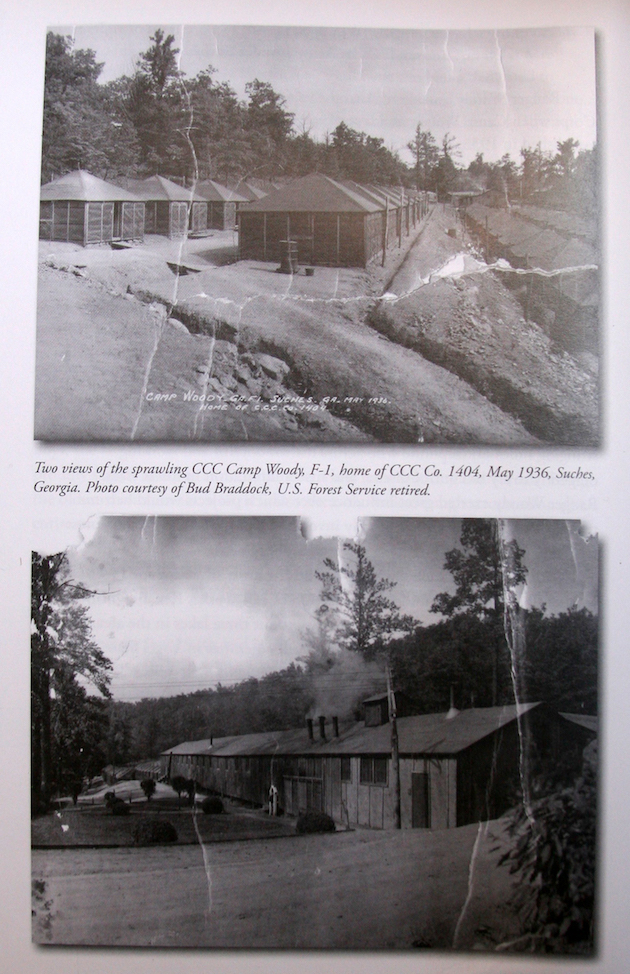
Men without work eventually become men without hope, and that’s bad for everyone.
Dallas, Washington DC, Atlanta, Augusta, and Tampa
I am back in Dallas for the next 10 days, hoping to use the time to catch up and reduce the 401 emails in my inbox. While I enjoyed my foray into New Jersey and getting to meet so many interesting people, I really did physically overdo it, and meanwhile the emails just piled up in drifts. But the writing deadlines never go away.
I will be in Washington DC on April 5 for George Friedman’s Geopolitical Futures Conference. I am really looking forward to this gathering, and I think there are a few spots left. Geopolitics specifically and politics in general have become more important than ever to our future in investing. I don’t particularly like that reality, but I have to live and invest in it.
I will go from DC to an evening in Atlanta before making my way to Augusta, Georgia, where Shane and I will be the guests of good friends at the Masters. I haven’t had much time for golf in the past few years, but I have always wanted to watch the Masters live on Saturday and Sunday with people who can make sure that I get to see the action, and on the most beautiful and storied golf course in the world.
I fly the next day for Tampa, where I will be in meetings with my friend Patrick Cox as some of his cutting-edge biotech friends come in to give us insights on their latest research. I don’t know how Patrick finds some of these researchers and gets in contact with them. Many of them are quite famous, but for whatever reason he seems to be able to get on the inside and tease information from them and share it. Some of the things they are discovering about the potential for postponing the ravages of aging are truly astounding, and I feel that I simply have to take a day out to absorb some of the latest and greatest developments. We do live in interesting times.
It is with more than a little nostalgia that I note the passing of Chuck Berry at age 90. Yes, I drove around in my car with no particular place to go, listening to his music. He was the true father of rock ’n’ roll and inspired later generations of musicians from the ’60s and ’70s – some of the most famous bands of that era covered his music, including the Beatles, the Rolling Stones, the Beach Boys, and so many others.
Many of us know his music, but not that many know his story. He spent some time in reform school, where he actually formed a quartet that was allowed to perform outside of the prison. He made two more trips to prison in his life. I add that note in the context of our discussion about the 20,000,000 felons we have here in the US. Think about how much poorer the world would be if Chuck Berry had not been able to make it just because he had a felony record.
Go to Google and type in “YouTube Chuck Berry.” Start with “Maybelline” and “Johnny B. Goode,” and then keep going. Chuck had dozens of hits, and the amazing thing is, he wrote his own material. What I did not expect to find was a jam-session concert, evidently at the Rock ’n’ Roll Hall of Fame, with Chuck Berry, Little Richard, and Jerry Lee Lewis. Then I noticed that the backup band was a young Bruce Springsteen and the E Street Band – and oh my God, there was Stevie Ray Vaughn!
As I hit the send button today, I fantasize about that moment in the future when an alien culture intercepts the Voyager satellite that we sent into space during Jimmy Carter’s presidency. They listen to all the sounds and read our science and literature and then come to the music, where they appreciate the majesty of Bach and Beethoven; but it is the one rock ’n’ roll song, Chuck Berry’s “Johnny B. Goode,” that makes them decide to come visit our planet. Yes, I still think it’s rock ’n’ roll music forever. RIP, Chuck Berry.
And with that, you have a great week. And if you’re of a certain era, let yourself get a little nostalgic kicking around on YouTube listing to Chuck Berry and all the other rock ’n’ roll greats. Sometimes you have to feed the soul.
Your thinking he should listen to more music analyst,

John Mauldin
subscribers@MauldinEconomics.com
| Digg This Article
-- Published: Tuesday, 21 March 2017 | E-Mail | Print | Source: GoldSeek.com

